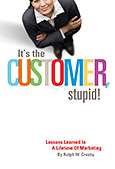Online — Content is Still King
Quality online content builds brand loyalty, moves customers to action, and brings them back for more. Your content must be easy to understand and easy to access. In a sense, online you must act more like a journalist than a marketer. Also, quality content can differentiate you from competitors who may be on the customer’s search list as well.
Some marketers call this informational approach a “pull” concept, whereby you draw in your customers rather than “pushing” your product or service at them through promotion. However, you can’t rely solely on a “pull” concept in marketing. Often, in order to pull you have to push. You must make customers aware of your product, service, or organization. While the mass media form of push may be inefficient, perhaps even obsolete, if used only by itself, the offline ad, news release, newsletter, etc., remain important parts of moving customers to action, especially if you want them to find you online. E-mail, blogs, and other online methods still “push” messages into the marketplace. In addition, many organizations even use push marketing on social media, such as Facebook, Twitter, MySpace, and others, to offer information and instruction.
Social media success is about content, not about technology. As recently reported in Adweek:
“Thanks to social media, the biggest challenge for brands is often less about creating the kind of technically sophisticated ‘immersive experiences’ that digital shops have specialized in and more about crafting engaging content that people are likely to share with each other.”
Once the customer learns where your site is on the Internet, you want him or her to return often so you can continue to build your relationship, i.e., brand loyalty. Therefore, changing your website content is critical. If it stays the same, customer visit after customer visit, the customer will get bored and stop visiting. Give the customers something fresh to see when they return and flag it on your homepage.
Changing content will stimulate interest, as scientists have discovered. As an example, they cite the placement of mobiles over babies’ cribs. Few parents read the instructions for installing a mobile for their infant. But, if they did, they would note the direction to change the mobile’s position around the crib every few days. This difference in positioning will stimulate the baby’s brain to process the change and consider it in a new way. In the same manner, organizations have to keep their websites dynamic and current so that visitors don’t become conditioned to them and ignore the messaging.

 Businesses often are started by entrepreneurs with an idea, a product or service, or an expertise. Many of them fail, not because the idea or product isn’t good, but because their attention is overwhelmingly directed internally – e.g., what goes into the product – when they should focus externally, always reminding themselves:
Businesses often are started by entrepreneurs with an idea, a product or service, or an expertise. Many of them fail, not because the idea or product isn’t good, but because their attention is overwhelmingly directed internally – e.g., what goes into the product – when they should focus externally, always reminding themselves:
